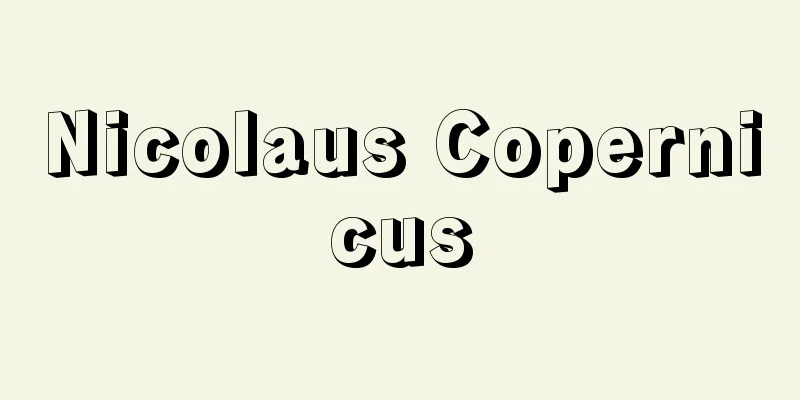Nicolaus Copernicus

|
Polish priest and astronomer. Founder of the heliocentric theory. Polish name Mikołaj Kopernik. Born as the youngest son of a copper wholesaler in Toruń, he lost his father at the age of 10 and was raised by his maternal uncle, priest Lucas Waczenrode (1447-1512), along with his siblings. In 1491, he entered the University of Krakow with the aim of becoming a priest. In the Department of Liberal Arts, he listened to lectures on mathematics and astronomy by philosophy professor Albert Brudzewski (1445-1497), and was enlightened and enlightened by his view of the universe. There, he pointed out the discrepancy between Ptolemy's geocentric theory at the time and the observational results compiled in the Catalogue of Alphonsus. At that time, the church festival calendar, which adopted the Julian calendar, was about 10 days behind the actual dates. In addition, the celestial almanac for celestial navigation, which was calculated based on the geocentric theory, could not be expected to be accurate. The former concerned religious authority, and the latter concerned the lives of navigators, and these social issues must have strengthened Copernicus' interest in astronomy. In 1496, with the support of his uncle, Copernicus traveled to northern Italy, the home of the Renaissance, to study, and transferred to the University of Bologna. This was the oldest university in Europe, and was also the alma mater of his uncle. He started by studying Greek, then moved on to Greek philosophy and astronomy. Domenico Maria Novara (1454-1504), a professor of astronomy, was a keen scholar who, by observing the obliquity of the ecliptic, realized that Ptolemy's cosmological system needed to be corrected. Copernicus studied under him, and in 1497 helped to observe the occultation of the star Aldebaran. In the same year, while still studying abroad, he was appointed councillor of the cathedral in Warmia by his native church, and was given permission to continue studying abroad. In 1500, he attended the Christmas festivities in Rome with his brother in official capacity, and stayed there for about a year, giving lectures on astronomy and observing lunar eclipses. In 1501, he returned to Italy and was granted permission to postpone his studies, and immediately returned to Italy to visit the University of Padua. After studying theology there, he transferred to the University of Ferrara and obtained a degree in theology in 1503. He returned to Padua to study medicine, and progressed to the point of receiving his degree in 1506. It is likely that during this time spent at various universities he solidified his conception of the Copernican universe, the so-called heliocentric theory; however, it is not clear at which university he came across the notes of Aristarchus of ancient Greece, which is said to have been his direct inspiration for this theory. After studying in Italy for about 10 years, he returned to Japan around 1506 and went to Heisberg, where his uncle was posted, to serve as his secretary and physician, and to accompany him on business trips. His medical skills made him famous, and he also devoted himself to treating the poor, which earned him popularity. In 1512, after his uncle passed away, he took up his post at the temple in Frombork (Frauenburg). During the day, he was in charge of clerical duties, medical care, and tax matters, and at night, he devoted himself to astronomical observations at the temple's observation tower, using a homemade angle measuring device. His goal was to confirm the heliocentric theory, and although his skills were not yet at the level of mastery and his observations were not accurate enough, he was confident that his predictions of celestial positions were superior to those based on the traditional geocentric theory. In 1514, he was summoned to the Papal Calendar Reform Council, but he declined. He gives the reason that the length of the solar year is still unresolved, but in reality, he seems to have been secretly concerned that the heliocentric theory is heretical in light of Catholic doctrine. Even though he was convinced of the heliocentric theory, it took great courage for him to write and publish it. In 1516, he was appointed auditor of the diocese of Elmland and councillor of the Allenstein Cathedral, but was transferred to his original post, Frombork, as archbishop in 1526. He passed away here 17 years later, and it is said that the first edition of his most important work, On the Revolutions of the Celestial Spheres, was delivered to his bedside on his deathbed. It seems that he spent 20 to 30 years writing his heliocentric theory. Around 1530, when he was nearing completion, he compiled his Outline. This Outline was the first theoretically written overview of the heliocentric theory, and was self-published in small numbers and distributed to active astronomers, mathematicians, and clergy. He also sent copies to Pope Clement VII and Bishop Nicolaus von Schönberg (1472-1537), who encouraged him to publish his main work. The direct motivation for Copernicus to decide to publish his major work was the enthusiasm of a young German mathematician, Rheticus. Impressed by the new theory described in Outlines, Rheticus became Copernicus's pupil in 1539 and studied under him for about a year. Upon returning to his home country, he begged Copernicus to publish it, and succeeded in persuading him to do so, and he was entrusted with the manuscript, promising to print it at the Gutenberg press in Nuremberg. However, shortly after returning to his home country, he was appointed professor at the University of Leipzig, and asked his friend, theologian Andreas Osiander (1498-1552), to take care of it from then on. To avoid any future worries, this caretaker added his own preface, which meant that the book was merely a convenient book of calculations. This was not Copernicus's original intention, but whether or not this prevented the book from being directly banned. In addition to his great achievements in astronomy, Copernicus also demonstrated his talents in politics and economics. When Olszczyn Castle was besieged by the Teutonic Knights from the end of 1519 to 1521, he stayed inside the castle to defend it. In 1528 he wrote De Monetaire, in which he pointed out, before Gresham, that the deterioration of currency was the cause of rising prices, and he also worked to reform the currency. [Shimamura Fukutaro] "Copernicus" by Hideo Hirose (1965, Maki Shoten)" ▽ "Copernicus" by F. Hoyle, translated by Ryuzo Nakajima (1974, Hosei University Press)" ▽ "On the Rotation of the Heavenly Bodies" translated by Yuri Yajima (Iwanami Bunko) [References] | | | | | | | | [Chronology] |It is located on the campus of the Jagiellonian University (then the University of Krakow), the oldest university in Poland where Copernicus studied. Poland, Krakow ©Shogakukan "> Copernicus Statue Source: Shogakukan Encyclopedia Nipponica About Encyclopedia Nipponica Information | Legend |
|
ポーランドの聖職者、天文学者。地動説の創設者。ポーランド名Mikołaj Kopernik。トルニの銅卸商の末子に生まれ、10歳で父を失い、兄姉とともに母方の伯父で聖職者のワッツェンローデLucas Waczenrode(1447―1512)に養われた。1491年、聖職を志してクラクフ大学に入学、学芸学科で哲学教授ブルゼウスキーAlbert Brudzewski(1445―1497)の数学、天文学の講義を聴き、宇宙観について啓発され、開眼した。そこでは、当時のプトレマイオスの天動説理論と『アルフォンス星表』にまとめられた観測結果との間のずれが指摘された。当時、ユリウス暦を採用していた教会祭礼暦は実際の日付より約10日の遅れがあった。また天動説に基づいて計算された天文航法用の天体位置暦は精密を期しえなかった。前者は宗教上の権威に、後者は航海者の生命にかかわる問題であり、この社会的問題がコペルニクスの天文学への関心を強めさせたに違いない。 1496年、伯父の援助でルネサンスの本拠地、北イタリアへの遊学が実現し、コペルニクスはボローニャ大学に編入した。ここはヨーロッパ最古の大学であり、伯父の出身校でもあった。ギリシア語の学習から始めて、ギリシア哲学、ギリシア天文学へと進んだ。天文学教授ノバラDomenico Maria Novara(1454―1504)は、黄道傾斜を観測してプトレマイオスの宇宙体系に訂正が必要なことをみいだした篤学の人であった。コペルニクスは彼に師事して、1497年にアルデバラン星の星食の観測を手伝った。この年、留学中のまま、母国の教団からワーミアの聖堂の評議員に任命され、さらに留学を引き続き認める許可も下りた。1500年にはローマの聖誕祭に兄とともに正式資格で参列し、約1年間滞在し、天文学の講演を行い、月食を観測した。 1501年いったん帰国し、改めて留学延期の承認を得、ただちにイタリアに戻ってパドバ大学を訪ねた。ここで神学の研修に励んだのち、1503年フェッラーラ大学に転じて神学の学位を得た。ふたたびパドバ大学に戻り医学を学び、1506年にはその学位を受けるまでに上達した。 この大学遍歴の間にコペルニクス宇宙体系、いわゆる地動説の構想を固めたに違いないのであるが、その直接の動機となったといわれる古代ギリシアのアリスタルコスの手記にどこの大学で接したかは明らかでない。 およそ10年間のイタリア留学を終え、1506年ごろ帰国し、伯父の任地ハイスベルクに赴き、秘書兼侍医として管内監督に、出張旅行に同行するなどして仕えた。彼の評判を高めたのは医療の技であり、貧民への施療にも精魂を注ぎ人望を集めた。1512年、伯父の他界とともに、フロムボルク(フラウエンブルク)の寺院に着任した。ここで昼間は聖職、医療、税務の任にあたり、夜間は寺院の望星台で、手製の測角器を専用して天体観測に励んだ。目ざすところは地動説の確認にあり、その技術は熟達の域には及ばず、観測精度は十分ではなかったが、天体位置の予測に関しては従来の天動説によるものよりは優れていることに自信をもった。1514年、教皇庁の改暦審議会に召請されたが辞退した。その理由として、太陽年の1年の長さが未解決であることなどをあげているが、その実は、地動説がカトリックの教義に照らし異端であることをひそかに配慮したためと思われる。地動説を確信しながらも、これを著述し公刊することは大きな勇気を必要とした。 1516年、エルムランド教区会計監査役兼アレンシュタイン寺院評議員に補されて転任したが、1526年にふたたび元のフロムボルクに大管区長として帰任することができた。そして17年後にこの地で永眠したのであるが、その臨終の枕辺(まくらべ)に彼の終生の主著『天球の回転について』の第一刷が届いたという。 地動説を執筆した期間は20~30年間に及んだらしい。そしてそれが完稿に近い1530年ごろ、『概要』をまとめた。この『概要』は理論的に書かれた太陽中心説の初めての概説書であり、小部数だけ自費出版され、活動的な天文学者・数学者・聖職者らに配布された。その一部は教皇クレメンス7世およびシェーンベルクNicolaus von Schönberg(1472―1537)僧正にも贈られ、僧正からは主著公刊の激励を受けた。 コペルニクスが主著出版の決意を固めた直接の動機は、ドイツの若い数学者レティクスの熱意による。『概要』に述べられた新説に感銘したレティクスは、1539年にコペルニクスに弟子入りし、およそ1年間教えを受けた。帰国にあたりその公刊を懇願し、説得に成功して、ニュルンベルクのグーテンベルク活版所での印刷を約して原稿を預かった。ところが帰国してまもなくライプツィヒ大学教授に就任することとなって、あとの世話を友人の神学者オシアンダーAndreas Osiander(1498―1552)に依頼した。この世話人は後顧の憂いを避けるために独自の序文を付した。つまりこの著書を単なる便宜的計算書としたのである。もとより著者コペルニクスの本意ではなかったが、それかあらぬか直接の禁書扱いを免れることができた。 以上のように天文学で偉大な業績をあげたコペルニクスは、政治・経済面でも敏腕を振るった。1519年末から1521年まで、オルスチン城がドイツ騎士団によって包囲された際、城内にとどまってこの城を守った。1528年には『貨幣論』を著し、ここでグレシャムに先だって、貨幣の劣悪化が物価騰貴の原因になることを指摘するなど、貨幣改革にも努めるなどした。 [島村福太郎] 『広瀬秀雄著『コペルニクス』(1965・牧書店)』▽『F・ホイル著、中島龍三訳『コペルニクス』(1974・法政大学出版局)』▽『矢島祐利訳『天体の回転について』(岩波文庫)』 [参照項目] | | | | | | | | [年表] |かつてコペルニクスが学んだポーランド最古の大学、ヤギエウォ大学(当時のクラクフ大学)構内にある。ポーランド クラクフ©Shogakukan"> コペルニクス像 出典 小学館 日本大百科全書(ニッポニカ)日本大百科全書(ニッポニカ)について 情報 | 凡例 |
Recommend
jasmone
…Jasmine oil is composed of benzyl acetate (65%),...
hypoid gear
...Also, as you go from the inner end to the oute...
About the Rule of God - About the Rule of God
…He became priest of Marseilles in about 439, and...
Abdel Krim
…Leader of the Moroccan Rif War. Also known as Ab...
Les biches (English spelling)
…After returning to the company in 1921, she achi...
Machine inference
Combining various pieces of information to draw ne...
dechirage (English spelling)
...It goes without saying that collage is also us...
Fusarium oxysporum (English name) Fusariumoxysporum
...The phenomenon in which the whole plant wilts,...
Direct cost, indirect cost
Cost elements that can be directly recognized as h...
Aluminum alum - aluminium alum
...When crystallized from hot water, large crysta...
Library of Congress Classification
...Of the approximately 130,000 classification it...
Front Army
An operational army positioned between the Imperia...
Wei, Jin, and Northern and Southern Dynasties Period
The period in China from the fall of the Later Han...
Acacia greggii (English spelling) Acaciagreggii
…[Hiroshi Aramata]. … *Some of the terminology th...
Muroto [city] - Muroto
A city in the southeastern part of Kochi Prefectur...









